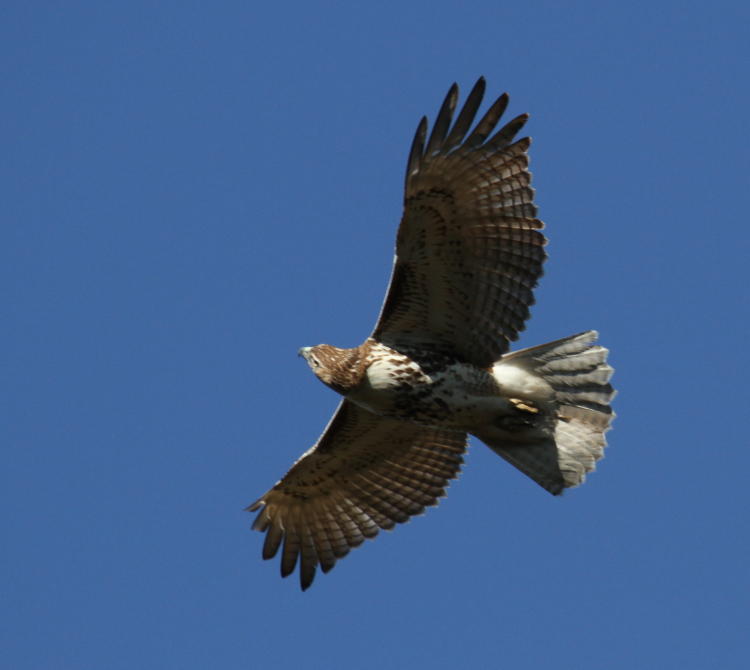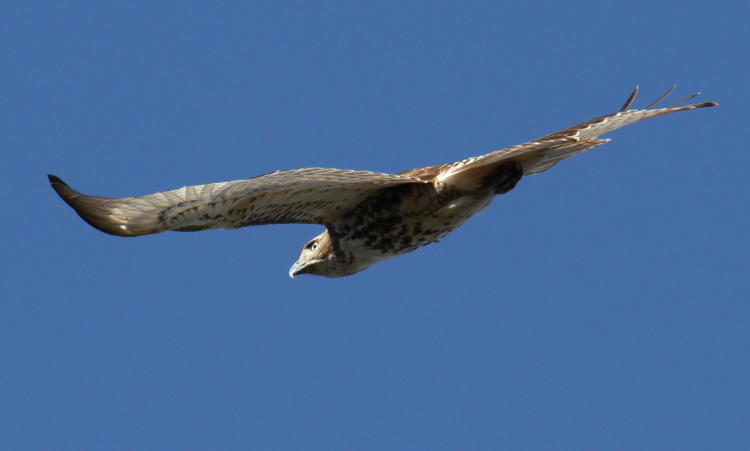You are surely not thinking in terms of some damn sports thing; how unbelievably lame that would be! No, naturally we’re talking about red-tailed hawks (Buteo jamaicensis) with the first bit, a pair of which were wheeling overhead earlier this morning. We’d gone through a solid day and night of rain, but the front pushed through leaving the skies crystal clear while dropping the temperature a bit, and the birds were celebrating this in fashion. I was still having a little bit of focus lock issues (appearing worse because of tight crops here,) and I’m still piecing together the reasons, but this is what we have for now.

For reasons unknown, what used to be the most-populated hawk in the area has been much lower in numbers in the past decade or so, at least by my observations (and we all know not to question those by now,) but seem to be on the increase, so I was happy to fire off a few shots in a brief session. And by “few,” I mean “79,” but they weren’t all hawks, plus I was doing sequences as the birds circled, hoping to catch the best fleeting light angles and behavior. Above, not the sharpest pic that I’ve ever taken, but I caught the hawk in mid call, at least. Below, however, represents one of the reasons that I will fire off a lot or frames, because such positions tend to last only a moment or so and are hard to make out in the viewfinder.

Now, the question for the ages, since the hawk was disinclined to answer me: is it looking up, or down? When I first saw them, before the camera was in hand – yes I put it down every once in a great while – there were two riding the thermals almost directly above the house, but by the time I returned with the 150-600 lens, one of them (judging from the unchanging location of the calls, because I never spotted it again,) had found a perch in a tree about 50 meters or so off. So I’m betting on ‘down,’ but who can say for sure in this day and age?
By the way, I say “riding the thermals” because that’s mostly how red-tails fly; they’re heavy birds and so conserve energy by picking days with nice updrafts to stay aloft over a prime area without flapping much at all. The crossroads very close by and the bright sunlight were combined to create a nice localized thermal in the immediate vicinity, so I could watch this one for several minutes without it moving off at all.
The next one, however, I’m not complaining about at all.

This is sized for the blog and for pleasant framing, and so doesn’t get the best treatment here, but the sharpness holds up to near-full resolution; it could be a tad sharper, but for a moving subject at 600mm, it’s pretty solid.
By the way, I just realized as I was typing this that the photos here represent both individuals, so I guess they traded off on perches or something. I’m inclined to say the first, at top, is the male, mostly because of the tail, but also because of the calling, which makes the other shots the female – notice the difference in belly speckling. That trait isn’t a gender thing, but variations found throughout the species; some have the barest hint of the “belly band,” while others barely have any clear patches.
Now, why the pair was behaving this way right now, I can’t say (at least until my attorney clears it.) It seemed like mating behavior, but this is entirely the wrong time of year for that. However, I may have to do a little research, partially because of the species appearing next.

Now we’ve gotten to the “blue” part, so you can stop fretting. These eastern bluebirds (Sialia sialis) – female on the left, male on the right – were among the very many birds active this morning, and a pair checked out the bluebird house within a few meters of my stance in the front yard; they may have been disappointed because I’m fairly certain that it’s presently occupied by a southern flying squirrel. While I’ve never had this confirmed by anyone with ornithological expertise, I’ve seen it often enough to believe it, but it seems bluebirds at least will check out potential nesting locales on their way south in the fall, to have a place in mind on their return in the spring. So were the red-tails doing the same? Or were they merely taking advantage of the conditions? Maybe we’re under surveillance by the avian cartel? Is something about to go down? If the blog suddenly goes quiet, check the news for something strange.




















































